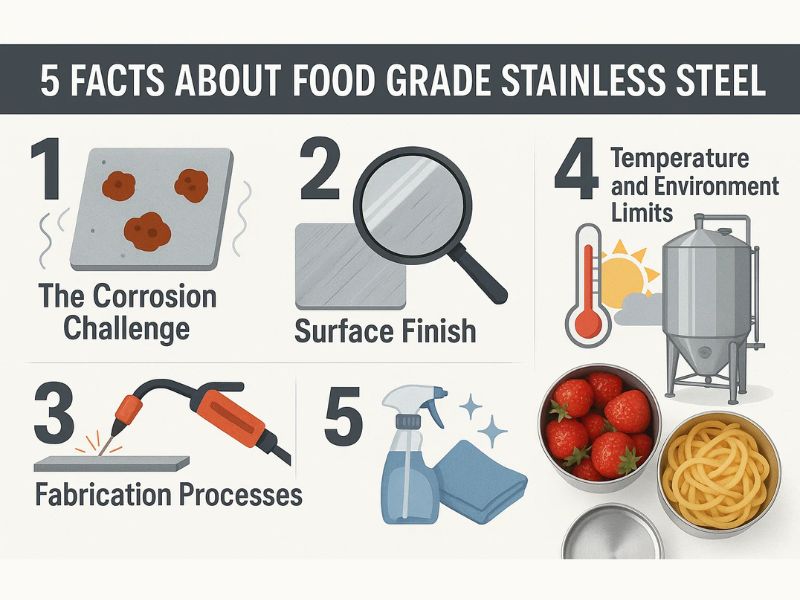- By Profab /
- October 16, 2025

Food grade stainless steel is essential for any facility handling consumables. Selecting the correct material is critical for guaranteeing safety and operational longevity. Food grade certification is not just about the alloy; it also involves surface integrity and strict regulatory compliance. Understanding the technical differences between stainless steel types is crucial for making informed procurement decisions.
Table of Contents
What Is Food Grade Stainless Steel?
Food grade stainless steel refers to specific stainless steel alloy grades safe for direct food contact. A metal is food grade only if it meets strict national and international rules. Key rules include the U.S. FDA Food Code and EU Regulation EC No. 1935/2004.
NSF/ANSI 51 is a common certification confirming materials and equipment are safe for food use. Know five core facts can help you choose and maintain sanitary equipment over time.
Fact 1: The Corrosion Challenge: Pitting and Chlorides
Pitting is the most common failure mode for stainless steel in the food industry. Grade 304 is particularly vulnerable in chloride-rich conditions such as salt, brine, or chlorine-based cleaning agents. Although 304 resists many corrosives, prolonged exposure to salt can still damage it.
By contrast, the molybdenum in Grade 316 significantly improves resistance to both pitting and crevice corrosion. That makes 316 last longer and perform more reliably in harsh environments. 316 is therefore recommended for seafood processing, for production involving strongly acidic foods (e.g., citrus or tomatoes), and for facilities that use aggressive, high-temperature CIP systems.
Fact 2: Surface Finish is Non-Negotiable
The steel’s surface finish controls how well the equipment resists bacterial growth. A smooth finish makes equipment easier to clean. Rough, pitted, or flawed surfaces create tiny crevices that trap food residue and bacteria. Once microbes settle into those crevices, normal cleaning often can’t remove them, which creates a serious contamination risk.
Harsh, abrasive finishing weakens the oxide locally and speeds up corrosion at the damaged spot. In short, a poor surface finish makes equipment both a hygiene hazard and more likely to corrode. Profab offers a wide range of surface treatments to meet food-grade stainless steel standards.
Fact 3: Fabrication Processes of Food Grade Stainless Steel
Welding Food Grade Stainless Steel Risks
Welding is a major threat to food grade stainless steel. Intense, localized heat from some welding methods can strip the chromium-oxide layer. Even Grade 316 can fail fast if welded poorly.
To lower this risk, manufacturers should use high-precision welding techniques, like a medium-frequency direct-current (MFDC) machine. This controlled approach helps preserve the passive layer near welds. Professional Profab follows strict, high-sanitary welding protocols.
Cold Working and Structural Change
A common confusion is whether stainless steel is magnetic. Austenitic grades like 304 and 316 have an austenite crystal structure and are generally non-magnetic in the annealed, soft state. Their electron arrangement does not produce strong magnetism.
Fabrication can create magnetism. Cold working—rolling, bending, stretching or forming—adds mechanical stress and deformation.
So, slight magnetism in fabricated 304 is usually normal and caused by processing, not poor alloy quality. By contrast, Grade 430 is naturally and strongly magnetic and is commonly used for kitchen utensils.
Fact 4: Temperature and Environment Limits of Food Grade Stainless Steel
Food grade stainless steel is suited for the rigorous thermal cycling required in food processing. These equipments must withstand cooking, freezing, and sterilization.
High-Temperature Oxidation Resistance
Stainless steel withstands the high temperatures used in sterilization and cooking. For most high-heat food applications, Grade 304 performs very well and resists oxidation up to about 1,697°F. That temperature is well above what nearly all food plants need.
Still, high temperatures bring mechanical risks. Rapid or repeated temperature swings cause fast expansion and contraction of the metal. Over many cycles this can cause fatigue, warping, or even breakage. Also, because 304 tolerates high heat, the heat added during welding is a serious local risk. That reinforces the need for controlled, low-heat fabrication to protect the steel during later sterilization cycles.
The Danger of Cryogenic Embrittlement
Austenitic grades like 304 and 316 work well across the normal operating range. However, their performance falls off at very low temperatures.
At truly cryogenic levels (below −49°F), many standard stainless steels risk cold brittleness. The metal becomes much more brittle and can crack suddenly. For specialized needs — for example, flash or cryogenic freezing of protein products — engineers specify martensitic stainless steels. Martensitic alloys are far less likely to become brittle at extreme cold. So they keep mechanical integrity where austenitic grades would fail.
In short: temperature limits determine the steel family. Austenitic 300-series (304/316) are chosen for corrosion resistance. Martensitic grades are chosen when extreme cold tolerance is required.
Fact 5: Improper Cleaning of Food Grade Stainless Steel
The final, crucial factor in ensuring the food-grade status and longevity of stainless steel equipment lies in operational protocols. Maintenance failure is often an indirect material failure, where poor protocols destroy the inherent chemical protection.
The Chlorides Attack
The main long-term threat to stainless-steel equipment is chemical attack from cleaning agents that contain chlorides. Chloride-containing cleaners are highly corrosive because they attack the passive chromium-oxide layer. Once that layer is breached, corrosion speeds up, and 304 stainless steel is especially prone to pitting.
To protect the passive layer, always use mild, food-safe, chloride-free detergents. For routine cleaning, warm soapy water with a gentle detergent is usually enough. For stubborn stains or burnt-on food, use a non-abrasive baking-soda paste. Avoid harsh chemicals and abrasive cleaners, including bleach, to maintain surface integrity.
Cross-Contamination and Abrasion
Using a steel brush causes mechanical cross-contamination. Tiny ferrous particles from the brush embed in the softer stainless surface. Those particles break the protective oxide layer and rust easily. The embedded rust then causes the stainless surface to oxidize. For this reason, never use the same tools on stainless and ordinary carbon steel.
Always wipe with a soft cloth or sponge and move with the grain of the steel. Wiping against the grain can leave streaks and create micro-scratches that invite localized corrosion.
Conclusion
Selecting the correct food grade stainless steel is vital for safety and operational longevity. Key differences between 304 and 316 alloys depend on required resistance to corrosive elements like salt. Proper maintenance and high-quality fabrication are equally essential for material integrity. Profab Machine offers specialized stainless steel engineering and fabrication solutions. We can make sure every custom stainless steel part meets the highest sanitary standards.
FAQ
Is 18/8 stainless steel food grade?
Yes. 18/8 stainless steel (also known as Type 304) is one of the most widely used food-grade materials. The numbers refer to its composition—about 18% chromium and 8% nickel—which provides excellent corrosion resistance, durability, and ease of cleaning. It is commonly used for kitchen equipment, cookware, and food processing machinery.
Is food-grade stainless steel magnetic?
Generally, no. Most food-grade stainless steels, such as 304 and 316, are austenitic, which means they are non-magnetic in their annealed (soft) state. However, slight magnetism can appear after cold working (bending, forming, or rolling). This mild magnetism is normal and does not affect the steel’s corrosion resistance or safety.
Is 430 stainless steel food grade?
Yes, 430 stainless steel is considered food grade, but it has different properties from 304 or 316. It contains less nickel, making it more affordable but less corrosion-resistant. It is magnetic and often used for kitchen appliances, decorative trims, and utensils where corrosion exposure is minimal. For wet or salty environments, 304 or 316 is still preferred for better durability and hygiene.
Send Inquiry Now
Related Resource
